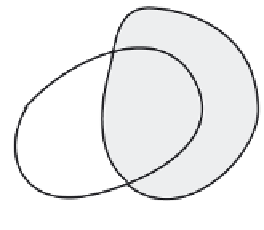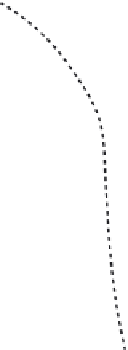Graphics Reference
In-Depth Information
Bulging to simulate
volume preservation
F
i
(
p
)
F
j
(
p
)
F
j
(
p
)
G
ij
(
p
)
0
F
i
(
p
)
G
ij
(
p
) 0
Surface of contact
Bulging to simulate
volume preservation
FIGURE 12.7
Implicit surfaces after deformation due to collision.
F
i
(
p
)
¼ F
j
(
p
). Thus,
the implicit functions, after they have been modified for deformation and evaluated for points
p
on the
contact surface, are merely
F
i
(
p
)
þ G
ij
(
p
)
¼
0 and
F
j
(
p
)
þ G
ji
(
p
)
¼
0, coincide with the surface defined by
F
i
(
p
)
F
j
(
p
)
¼
0 and
F
j
(p)
F
i
(
p
)
¼
0, respectively. Thus,
G
ij
evaluates
to
F
j
at the surface of contact.
In the penetration region, the
G
s are negative in order to compress the respective implicit surfaces as
a result of the collision. They are defined so that their effect smoothly fades away for points at the
boundary of the penetration region. Consequently, the
G
s are merely the negative of the
F
s for points
G
ij
ð pÞ¼F
j
ð pÞ
G
ji
ð pÞ¼F
i
ð pÞ
(12.3)
To simulate volume preservation, an additional term is added to the
G
s so that they evaluate to a
positive value in the propagation region immediately adjacent to, but just outside, the penetration
region. The effect of the positive evaluation will be to bulge out the implicit surface around the newly
formed surface of contact (
Figure 12.7
)
.
In the propagation region,
G
(
p
) is defined as a function,
h
, of the distance to the border of the inter-
penetration region. To ensure
C
1
continuity between the interpenetration region and the propagation
region,
h
0
(0) must be equal to the directional derivative of
G
along the gradient at point
p
(
k
in
Figure 12.8
)
. See Gascuel [
6
] and Gascuel and Gascuel [
7
] for more details.
Restoring forces, which arise as a result of the deformed surfaces, are computed and added to any
other external forces acting on the two objects. The magnitude of the force is simply the deformation
term,
G
; it is in the direction of the normal to the deformed surface at point
p
.















Search WWH ::

Custom Search